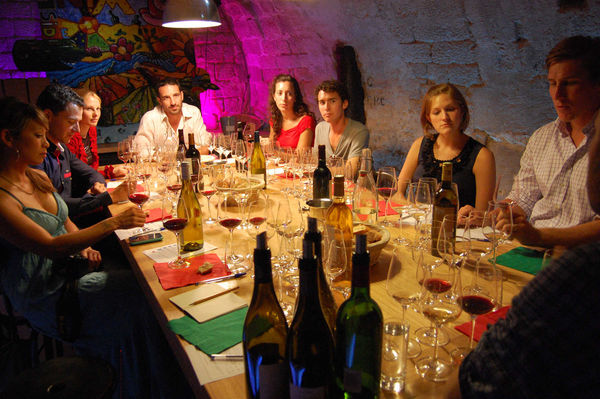Lessons from a Paris Wine-Tasting
By Rick Steves
France is peppered with wineries and wine-tasting opportunities. For some people, it can be overwhelming to try to make sense of the vast range of French wines, particularly when faced with a no-nonsense winemaker or sommelier.
I'm no wine expert and would never claim to be, but I've learned a lot from Olivier Magny, a young Parisian sommelier who gathers tourists for wine-tastings in a royal cellar a block from the Louvre. The last time I was there, Olivier gave us a wonderful commentary. Here's what I gleaned from his presentation:
White wine should be clear…if not, it's Spanish.
Acidity is like salt. It gives wine character. "Legs," a.k.a. "tears," indicates how much sugar is in the wine. Dry wine has fewer legs; sweet wine has more and faster-running legs.
When you sip a little wine and then suck air in, it exaggerates the character. You're not making it better, but bringing out its flavors, so that it's easier to identify the characteristics of that particular wine. Olivier feels that Americans need to break out of their four favorite words to describe the taste of wine: "dry, sweet, fruity, oaky."
The Champagne region defended its name and therefore has a strong image today. The Chablis region did not, so winegrowers outside of France used the name and made it cheaply. Today the real Chablis is better than its reputation.
Terroir (pronounced "tehr-wah") is a uniquely French concept. The French don't call a wine by the grape's name. Two wines can be made of the same grape, but be of very different character because of their terroir. A real Chablis made from the Chardonnay grape is better than Chardonnays made elsewhere because of its terroir. Terroir is "somewhere-ness," a combination of the macro- and microclimate, soil, geology, and culture (the accumulated experience of the people and their craft).
Grapevines are creepers, with roots going through the topsoil and into the geology deep down. The roots are commonly 150 feet long and deep. While topsoil can be influenced by the vintner, the deep geology cannot; and this gives the wine a distinct character. The French do not allow irrigation, thus forcing the grapes to search deep for water.
There are two basic kinds of wine in this world: that of big growers and that of little growers. Big business works better for wine in places like Argentina and Australia (where three companies dominate the wine industry). Most French wine is still made by thousands of small, independent, and passionate vintners.
The French are not enthusiastic about the oaky taste of American wine. A French vintner went to a wine conference in California, where some wineries use barrels made from American oak rather than French oak. When pressed to comment on California wines, he said, "I don't like oak shaping my wine. When I drink Californian wine, I feel like I'm kissing Pinocchio." (Actually, he had a more graphic way of describing it.) Without the focus on oak-barrel aging, and because of the business environment that encourages small outfits, Olivier says French wine is lighter and more diverse.
Because of global climate change, wine in general is sweeter these days. A grape can't be harvested properly until it's both sweet enough and the tannins are right. This used to happen at about the same time. But lately the grapes are sweet many days before the tannin level is ready. Consequently, when the tannins are right and the grapes can be harvested, they are sweeter than is optimal. Before, the average wine was 11 percent alcohol; now it's 13 percent.
Everyone wants Bordeaux Grand Cru, and that demand drives up the price. That's why Bordeaux, while very good, is overpriced. Burgundy makes only about 3 percent of all French wine. Because of its reputation and the demand, it is overpriced as well.
Back when rooms were cooler, the idea that red wine is best drunk at room temperature was established. But room temperature is higher now than it used to be. Consequently, many restaurants serve their reds too warm. It's perfectly acceptable to ask for it to be chilled; five or 10 minutes in the fridge, and it'll be just right.
Generally, in France you'll get light wines in the north, and big, full-bodied wines in the south where it's sunnier. A big name (e.g., Bordeaux, Burgundy) means a big price. A small name (e.g., Languedoc, Sud-Ouest) means potentially better value. Languedoc can be a great value for a big Syrah. A high-end Languedoc costs less than a low-end Bordeaux. Of the thousand different grapes that make good wine, 10 are famous.
Olivier's best tip about French wine came at the end: Don't be intimidated — break out and experiment. Santé!

